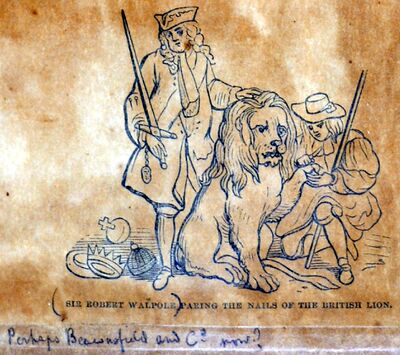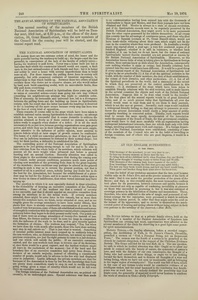The White Lady
A writer in “Notes and Queries” of December 26th, relates the two following interesting accounts of the appearance of spirits. He remarks:—
“The first of these stories I had from Grafin Louise K. who was told it by one of the ghost-seers, for there were several. The cholera was raging in Bavaria; several of the small mountain villages had been literally depopulated. The late King Louis, Queen Therese, and the Court were at Aschaffenburg, as the pestilence was peculiarly fatal in Munich—a place Queen Therese disliked very much—when, either on account of some State ceremonial, or from one of his usual fits of restlessness, King Louis announced that the Court would return to Munich in three days. The evening before they started the Queen and several of her ladies were sitting in one of her apartments in the palace, the last but one of the suite. She was in low spirits and all were unhappy at the prospect of the return to Munich. It was a warm summer evening drawing on to dusk. Presently a lady dressed in white came into the room, and making a slight reverence to the Queen, passed on into the inner room, which opened from the one in which they were sitting. A few moments after she had passed it struck all present that they did not recognise her, also that none of the other ladies on that day were wearing white dresses. The Queen and some others stood up and went into the room to see whom it might be, and found it empty! There was no mode of egress except the door by which they had entered, and the room was on the second story, so that no one could have got out of the window. Suddenly all felt that it must have been the White Lady,’ whose visit is believed to foretell the death of one of the Bavarian royal family, and some of the ladies fainted. The Court went to Munich on the next day according to appointment, and three days after Queen Therese was dead of the cholera.
“The second story is this. My father’s regiment was stationed at Clare Castle, in the County Clare, Ireland; this was during part of the Peninsular War. He had not long joined, and was not married, but his cousin, the late Major F. D., then a captain, and his wife, were also with the regiment. It was the beginning of winter; the regiment had been only a week in the castle, and no one expected a move before spring. Mrs. D. had been giving some directions about her rooms, when her maid said to her:—‘It will not be worth your while, ma'am, to get these things, as the regiment will be marching in a day or two.' Mrs. D. said, ‘Impossible, we are here for the winter, at least.’ ‘Oh, ma’am,' said the maid, ‘the white lady was seen on the battlements last night, by the sentries, and whenever she appears the route comes within the welk.’ The tradition was, that a lady in white was seen to walk about on the ramparts, wringing her hands, weeping bitterly, just before the route came for any regiment stationed in the castle. She was said to have been the wife of an officer who had died of grief, in consequence of her husband having been suddenly ordered oft on foreign service. The route came before two hours, and in two days the regiment had left the castle. This was told me by Mrs. D. herself, and is perfectly unaccountable. When none of the officers knew anything of the approaching move, it does not seem likely that the wife of one of the men (such, I believe, was Mrs. D.’s servant), could know anything about it, and the regiment, as before said, had only arrived at the castle within the week.”

An Old English Superstition
Wild blossoms of the moorland, ye are very dear to me; |
It was the belief of our credulous ancestors that the fern seed became visible only on St. John’s Eve, and at the precise moment of the birth of the saint; that it was under the peculiar protection of the queen of the fairies; and that, in this eventful night, the most tremendous conflicts took place for its possession, between sorcerers and spirits, because it was conceived not only as capable of conferring invisibility at pleasure on those who succeeded in procuring it, but it was also esteemed of sovereign potency in the fabrication of charms and incantations. Those, therefore, who were addicted to the arts of magic, and possessed of sufficient courage for the enterprise, were presumed to watch in solitude during this solemn period, in order that they might seize the seed on the instant of its appearance, and so secure to themselves the much coveted power of hearing and seeing others without being subject in their own persons to the scrutiny of the observed.—Bow Sells.
Letter from London
Writing to a friend in this city, M. A. (Oxon) says, Col. Olcott’s “People from the Other World” adds a I very powerful link to the chain of evidence in forms of Materialization, which is now, for the first time, beginning to carry any weight. I could not for a long time get any evidence that sufficed to overcome the inherent improbability that such things should be. I don’t think we lay stress enough on that. To minds trained in a severely logical school it is inevitable that such portentous allegation should require portentous proof.
I know so much of the power of spirits over gross matter, that no amount of tying, &c., is of any real good as evidence. I must have medium and spirit together, or, still better, no cabinet: only a curtain across one corner of the room to which there is no access. But, my dear Sir, we are only just beginning to pierce the surface of this matter. What a marvelous phase of it is that shown in the transfiguration of Mrs. Compton of Havana. How bewildering it is in the idea that it gives rise to! If it be possible to so change the appearance of a woman, homely, toilworn, and ill-looking as Mrs. C. is, to that of a young and lovely girl in resplendent bridal costume, why may it not be possible to present a medium in all sorts of characters at the will of the operating spirits? The trustworthy evidence which establishes it in the case of Mrs. C., leads me to suspect that the same modus operandi may be at work in other cases, where the spirits are not as ready to confess it. And so what we think may be the materialization of a form, may in reality be something totally different, namely, a change in the medium’s physical body, or in our senses. It seems to me that these points must be cleared up before we can say positively in any given case— and each case must rest on its own merits—“this is a case where a living, material, human body has been created by the will of invisible operators.”
Cases then doubtless are in which each has been done. I am more and more sure that they are not as frequent as we think. And the power of these invisible agencies is so great that we can say of no one thing that it is unlikely or impossible.
I am now engaged in attending a series of materialization seances with Herne, (who was formerly in partnership with Williams.) He is one of our most powerful physical mediums, and I hope, will be able to show us some good results. A1 ready we have had three or four good materializations, or what profess to be so, in a single sitting. I am allowing the spirits to work up to a satisfactory pitch, and I shall then impose tests. At present we have some that are complete. It is very easy to prevent all manifestations by too rapid tests, and I prefer Crooker’s plan of giving the spirits their own conditions at first, until they know what they can do, and then praying and trying them.
The affaire Buguet in Paris is a very sad business. If you have seen the evidence put forward in Human Nature, you <... continues on page 3-230 >
Editor's notes
- ↑ The White Lady by unknown author, Spiritual Scientist, v. 2, No. 16, June 24, 1875, p. 189
- ↑ Sir Robert Walpole Paring the Nails of the British Lion by unknown author
- ↑ An Old English Superstition by unknown author (signed as Bow Bells), London Spiritualist, No. 195, May 19, 1876, p. 240
- ↑ Letter from London by Moses, W. S. (signed as M. A. (Oxon)), Spiritual Scientist, v. 2, No. 16, June 24, 1875, pp. 189-90
Sources
-
Spiritual Scientist, v. 2, No. 16, June 24, 1875, p. 189
-
London Spiritualist, No. 195, May 19, 1876, p. 240



